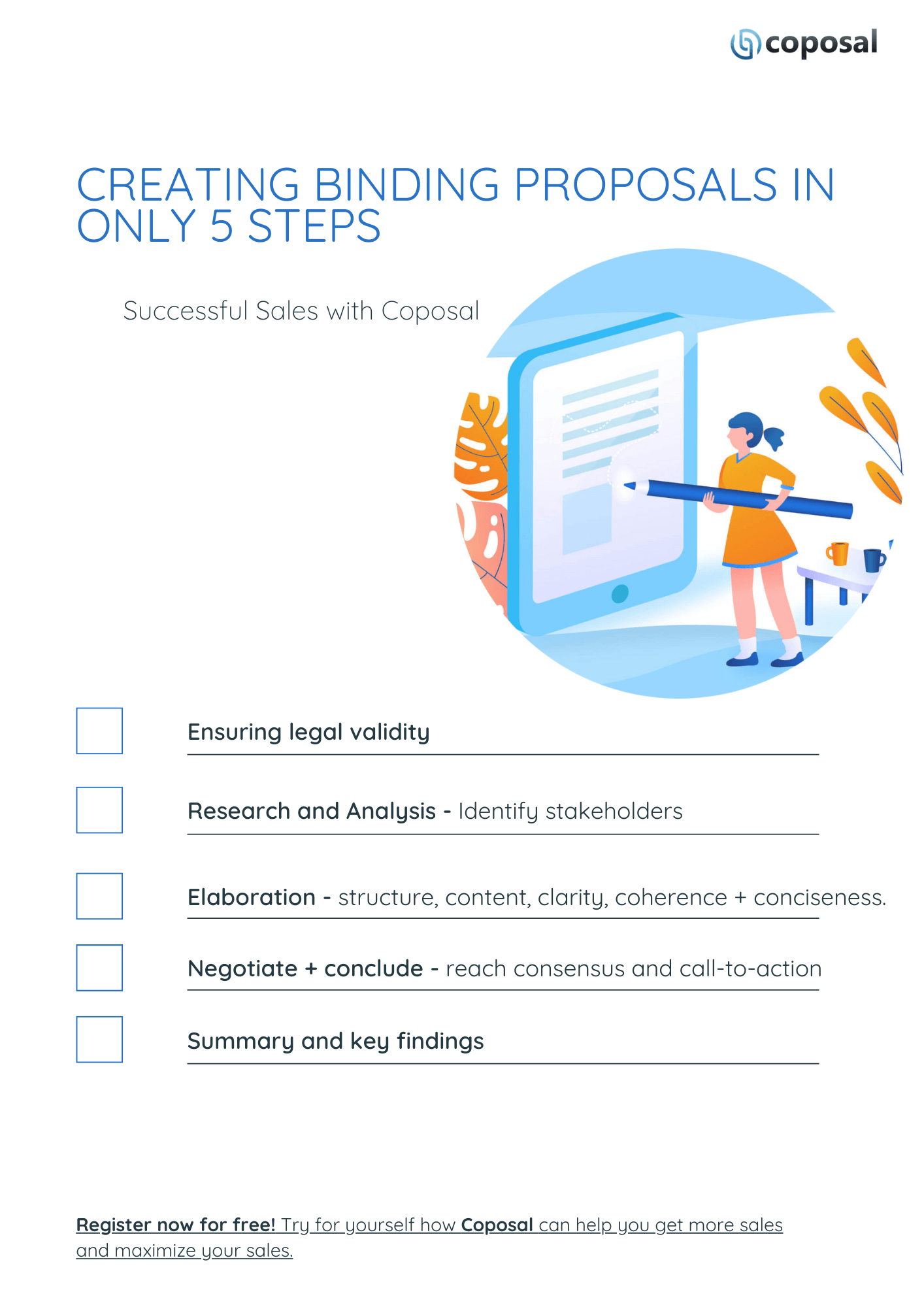
In business, proposals serve as essential tools for presenting ideas, services, or products to potential customers.
Among the various types of proposals, binding proposals are of great importance. But what exactly is a binding proposal and what should be considered when writing one?
Table of Contents
What is a binding proposal?
Binding proposals are formal documents outlining the terms and proposals that one party submits to another.
Proposals serve as a basis for agreements, contracts, or partnerships between parties involved in various business transactions.

Importance
To create clear expectations, minimize misunderstandings, and ensure legal enforceability in business transactions, creating binding proposals is essential.
Definition and Concept
Binding proposals are formal proposals made with the intention of entering into a contractual agreement upon acceptance by the receiving party.
These proposals typically detail the scope of work, services to be provided, schedules, prices, and terms of the contract.
Components of a binding proposal
A comprehensive binding proposal includes sections such as
- Introduction
- Background
- Objectives
- Methodology
- Schedule
- Results
- Prices
- Terms and Conditions
- Acceptance Criteria
- and Signatures
Ensuring Legal Validity
 To be binding, proposals must comply with legal standards.
To be binding, proposals must comply with legal standards.
Using clear and concise legal language ensures mutual understanding and agreement between the parties.
For clarity and transparency, the inclusion of terms and conditions outlining the rights and obligations of both parties is crucial.
Consulting with legal experts during the drafting process can help identify potential legal pitfalls and ensure compliance with relevant regulations.
Creating a Binding Proposal - Preparations

Research and Analysis
Before drafting a binding proposal, thorough research and analysis of the project or opportunity are necessary.
This includes understanding the needs, preferences, and expectations of the potential customer or partner.
Identify Stakeholders
Identifying key stakeholders involved in the decision-making process is crucial to tailor the proposal to effectively address their concerns and priorities.
Set Goals
Clearly defined goals help align the proposal with desired outcomes and demonstrate added value to the recipient.
Drafting the Proposal

Structure
Organize the proposal in a logical sequence, starting with an introduction, followed by background information, proposed solutions, benefits, and terms.
Develop Content
Create clear, concise, and compelling content that highlights the unique value proposition, addresses potential challenges, and outlines actionable steps.
Add Visual Elements
Incorporate visual elements such as charts, graphs, and images to enhance clarity, engagement, and visual appeal.
Proofreading and Editing
Thoroughly review the proposal for grammar errors, typos, and inconsistencies. Edit content for clarity, coherence, and conciseness.
Solicit Feedback
Seek input from colleagues, mentors, or subject matter experts to ensure that the proposal is comprehensive, compelling, and aligned with the goals.
Revise
Revise the proposal based on the received feedback to improve clarity, address concerns, and strengthen the overall presentation.
Negotiation and Conclusion

Addressing Concerns and Objections
Anticipate potential objections or concerns from the recipient and prepare responses that address their interests and priorities.
Reaching Consensus
Engage in constructive dialogues, negotiations, and compromises to achieve an agreement acceptable to both parties that meets the needs of all involved.
Call-To-Action
Once all adjustments have been made, it is important to set a Call-To-Action to finalize the proposal. Typically, this is the binding confirmation of your binding proposal.
Summary and Key Insights
By following the steps described, incorporating best practices, and addressing common concerns and questions, binding proposals can be created simply and systematically.
Remember that creating binding proposals is not just about closing deals but also about building trust, promoting collaboration, and achieving common goals.
 Reading Tip: If our article has helped you and you want more tips on writing proposals, continue reading here: "Pitfalls and other mistakes to avoid in proposal writing"
Reading Tip: If our article has helped you and you want more tips on writing proposals, continue reading here: "Pitfalls and other mistakes to avoid in proposal writing"
Frequently Asked Questions about Binding Proposals
How can I ensure that my binding proposal is legally enforceable?
To ensure the legal enforceability of your binding proposal, it is advisable to consult legal experts or professionals familiar with contract law.
They can assist in formulating clauses, terms, and conditions that comply with relevant laws and regulations.
Furthermore, clearly defining rights, obligations, and remedies in case of breach of contract enhances enforceability.
What should I do if the recipient requests changes to the proposal?
Evaluate the proposed changes in terms of their impact on the goals, scope, and feasibility of the agreement.
Engage in open communication and negotiation to find mutually acceptable solutions that meet the needs and interests of both parties while maintaining the integrity of the proposal.
Can I use templates to create binding proposals?
Yes, using templates to create binding proposals can streamline the process and ensure consistency and professionalism in formatting and content.
However, it is important to customize the template to reflect the specific requirements, preferences, and context of each proposal to maximize its effectiveness and relevance.
Is it necessary to include a schedule in the proposal?
Inclusion is highly recommended as it provides clarity on project milestones, deadlines, and deliverables, demonstrating feasibility and accountability.
A clearly defined schedule helps manage expectations, coordinate activities, and track progress throughout the engagement, improving transparency and communication.
How can I differentiate my proposal from the competition?
To differentiate your proposal from the competition, focus on presenting your unique value proposition, expertise, and insights tailored to the recipient's needs and priorities.
Highlighting success stories, case studies, and testimonials can strengthen the credibility of your proposal and set it apart from others. Additionally, personalized details, innovative solutions, and attention to detail can leave a lasting impression on the recipient.
What role do negotiations play in drafting binding proposals?
Negotiations play a crucial role in finalizing binding proposals by facilitating mutual agreement, understanding, and commitment between the parties.
Effective negotiation requires active listening, creative problem-solving, and willingness to compromise to achieve a win-win outcome.
By addressing concerns, clarifying expectations, and exploring options together, negotiation leaders can build trust and strengthen relationships, leading to successful agreements.